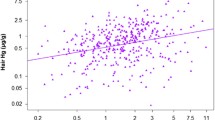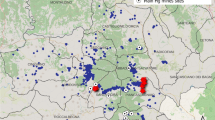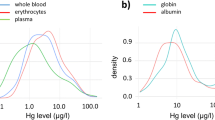Summary
In a mercury mobilization test, 0.3 g of the complexing agent sodium 2,3-dimercaptopropane-1-sulfonate (DMPS) was given orally to 10 workers with moderate occupational exposure to elemental mercury vapour, controls, and to 5 referents without amalgam fillings. In the workers, DMPS caused an increase in 24-h urinary mercury excretion by a factor of 10; in the dentists, 5.9; in the controls, 5.3; and in the amalgam-free referents, 3.8. Of the mercury excreted during 24 h, 59% appeared during the first 6 h. Close, albeit non-linear, associations were found between mobilized mercury and the premobilization mercury levels in plasma and urine, but not with the duration of occupational exposure or the rough estimate of the integrated function of blood levels vs. time. The present data indicate that mercury mobilized after a single DMPS dose in close connection with exposure is mainly an index of recent exposure and is not significantly affected by slow body pools or long-term exposure.
Similar content being viewed by others
References
Åkesson I, Schütz A, Attewell R, Skerfving S, Glantz P-O (1991) Mercury and selenium status in dental personell-impact of amalgam fillings. Arch Environ Health 46:102–109
Birke G, Johnels A, Plantin L-O, Sjöstrand B, Skerfving S, Westermark T (1972) Studies on humans exposed to methyl mercury through fish consumption. Arch Environ Health 25:77–91
Böckers M, Schönberger W, Oster O, Neumann P (1983) Inhalative Quecksilbervergiftung unter dem klinischen Bild einer Akrodynie (Selter-Swift-Feer). Dtsch Med Wochenschr 108:825–828
Campbell JR, Clarkson TW, Omar MD (1986) The therapeutic use of 2,3-dimercaptopropane-1-sulfonate rate in two cases of inorganic mercury poisoning. JAMA 256:3127–3130
Cherian GM, Miles EF, Clarkson TW, Cox C (1988) Estimation of mercury burdens in rats by chelation with dimercaptopropane sulfonate. J Pharmacol Exp Ther 245:479–484
Cikrt M, Tichy M (1980) Effects of some chelating agents on the biliary excretion of mercury. 1 Excretion kinetics and distribution of mercury in the organism. J Hyg Epidemiol Microbiol Immunol 24:346–355
Clarkson TW, Magos L, Cox C (1981) Test of efficacy of antidotes for removal of methylmercury in human poisoning during the Iraq outbreak. J Pharmacol Exp Ther 218:74–83
Clarkson TW, Friberg L, Hursh JB, Nylander M (1988a) The prediction of intake of mercury vapor from amalgams. In: Clarkson TW, Friberg L, Nordberg GF, Sager P (eds). Biological monitoring of toxic metals. Plenum Press, New York, pp 247–264
Clarkson TW, Hursh JB, Sager PR, Syversen TLM (1988b) Mercury. In: Clarkson TW, Friberg L, Nordberg GF, Sager PR, eds. Biological monitoring of toxic metals. Plenum Press, New York, pp 199–246
Dubinsky AA, Guida PP (1979) Side effects of unithiol, a sulfydryl group donor. Vrach Delo 2:68–71
Einarsson Ö, Lindstedt G, Bergström T (1984) A computerized automatic apparatus for determination of mercury in biological samples. J Automat Chem 6:74–79
Gabard B (1976) The excretion and distribution of inorganic mercury in the rat as influenced by several chelating agents. Arch of Toxicol 35:15–24
Gabard B (1978) Distribution and excretion of the mercury chelating agent 2,3-dimercaptopropan-1-sulphonate in the rat. Arch Toxicol 39:289–298
Hargreaves RJ, Evans JG, Janota I, Magos L, Cavanagh JB (1988) Persistent mercury in nerve cells 16 years after metallic mercury poisoning. Neuropathol Appl Neurobiol 14:443–452
Hursh JB, Greenwood MR, Clarkson TW, Allen J, Demuth S (1980) The effect of ethanol on the fate of mercury vapor inhaled by man. J Pharmacol Exp Ther 214:520–527
Hursh JB, Clarkson TW, Nowak TV, Pabico RC, McKenna BA, Miles E, Gibb FR (1985) Prediction of kidney mercury content by isotope techniques. Kidney Int 27:898–907
Jones MM, Basinger MA, Weaver AD, Davis CM, Vaughan WK (1980) Comparison of standard chelating agents for acute mercuric chloride poisoning in mice. Res Commun Chem Pathol Pharmacol 27:363–372
Kosta L, Byrne AR, Zelenko V (1975) Correlation between selenium and mercury in man following exposurse to inorganic mercury. Nature 254:238–239
Langworth S, Elinder C-G, Åkesson A (1988) Mercury exposure from dental fillings. I. Mercury concentrations in blood and urine. Swed Dent J 12:69–70
Lindstedt G (1970) A rapid method for the determination of mercury in urine. Analyst 95:264–274
Lindstedt G, Gottberg I, Holmgren B, Jonsson T, Karlsson G (1979) Individual mercury exposure of chloralkali workers and its relation to blood and urinary mercury levels. Scand J Work Environ Health 5:59–69
Lundgren K-D, Swensson Å, Ulfvarson U (1967) Studies in humans on the distribution of mercury in blood and the excretion in urine after exposure to different mercury compounds. Scand J Clin Lab Invest 20:164–167
Lustgarten JA, Wenk RE (1972) Simple, rapid kinetic method for serum creatinine measurement. Clin Chem 18:1419–1422
Mant TGK (1985) Clinical studies with dimercaptopropane sulfonate in mercury poisoning. Hum Toxicol (Abstract) 4:346
Möller-Madsen B, Hansen JC, Kragstrup J (1988) Mercury concentrations in blood from Danish dentists. Scand J Dent Res 96:56–59
Molin M, Marklund S, Bergman B, Bergman M, Stenman E (1987) Plasma-selenium, glutathione peroxidase in erythrocytes and mercury in patients allegedly subject to oral glavanism. Scand J Dent Res 95:328–334
Molin M, Bergman B, Marklund S, Nilsson B (1989) Mercury, selenium and glutathione peroxidase in dental personnel. Acta Odontol Scand 47:383–390
Molin M, Bergman B, Marklund S, Schütz A, Skerfving S (1990a) Mercury, selenium and gluthatione peroxidase before and after removal of dental amalgam in man. Acta Odontol Scand 48:189–202
Molin M, Bergman B, Marklund S, Schütz A, Skerfving S (1990b) The influence of placement of dental amalgam in man on mercury, selenium and glutathione peroxidase. Acta Odont Scand 48:287–295
Nilsson B, Nilsson B (1986a) Mercury in dental practice. I. The working environment of dental personnel and their exposure to mercury vapor. Swed Dent J 10:1–14
Nilsson B, Nilsson B (1986b) Mercury in dental practice. III. Urinary mercury excretion in dental personnel. Swed Dent J 10:221–232
Nordberg G, Skerfving S (1972) Metabolism. In: Friberg L, Vostal J (eds) Mercury in the environment. CRC Press, Cleveland, pp 29–91
Nylander M, Weiner J (1989) Relation between mercury and selenium in pituitary glands of dental staff. Br J Ind Med 46:751–752
Nylander M, Friberg L, Lind B (1987) Mercury concentrations in the human brain and kidneys in relation to exposure from amalgam fillings. Swed Dent J 11:179–187
Nylander M, Friberg L, Eggleston D, Björkman L (1989) Mercury accumulation in tissues from dental staff and controls in relation to exposure. Swed Dent J 13:235–243
Olstadt ML, Holland RI, Wandel N, Hensten-Pettersen A (1987) Correlation between amalgam restorations and mercury concentrations in urine. J Dent Res 66:1179–1182
Schiele R, Kröncke A (1989) Quecksilber-Mobilisation durch DMPS (Dimaval) bei Personen mit und ohne Amalgamfüllungen. Zahnaerztl Mitt 17:1866–1868
Skate I (1972) Microdetermination of mercury in biological samples. III. Automated determination of mercury in urine, fish and blood samples. Analyst 97:148–155
Takahata N, Hayashi H, Watanabe S, Anso T (1970) Accumulation of mercury in the brains of two autopsy cases with chronic inorganic mercury poisoning. Folia Psychiatr Neurol Jpn 24:59–69
Author information
Authors and Affiliations
Rights and permissions
About this article
Cite this article
Molin, M., Schütz, A., Skerfving, S. et al. Mobilized mercury in subjects with varying exposure to elemental mercury vapour. Int. Arch Occup Environ Heath 63, 187–192 (1991). https://doi.org/10.1007/BF00381567
Received:
Accepted:
Issue Date:
DOI: https://doi.org/10.1007/BF00381567




